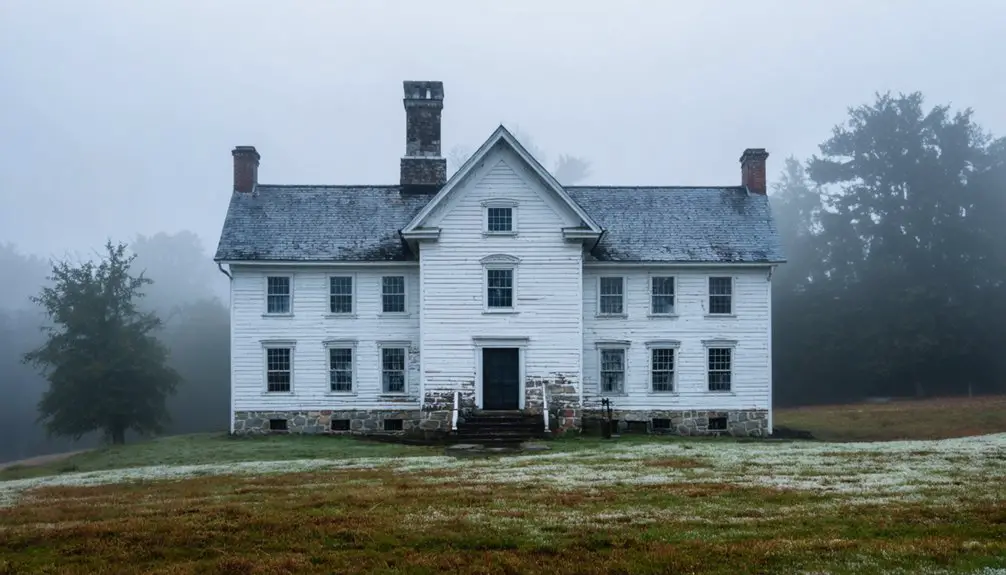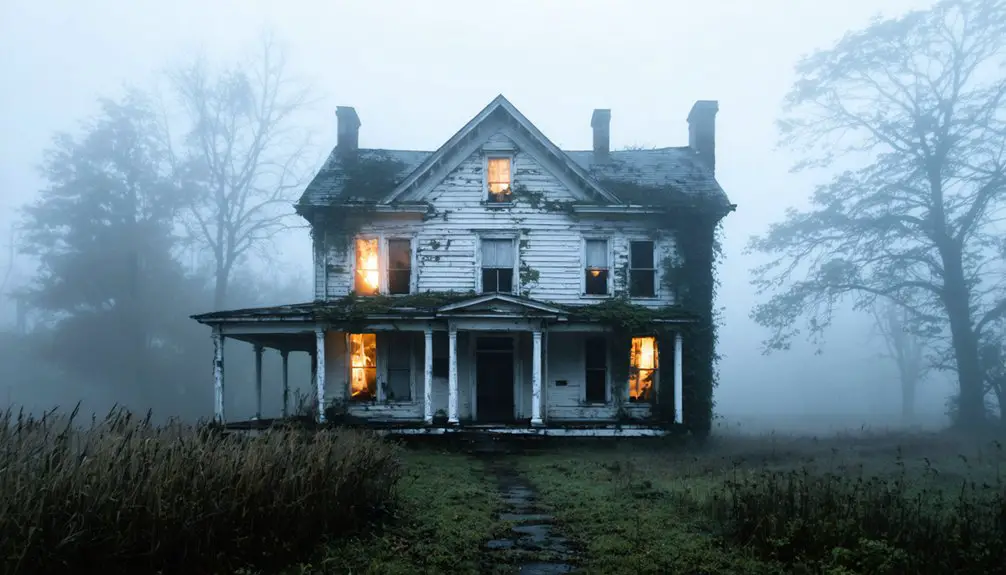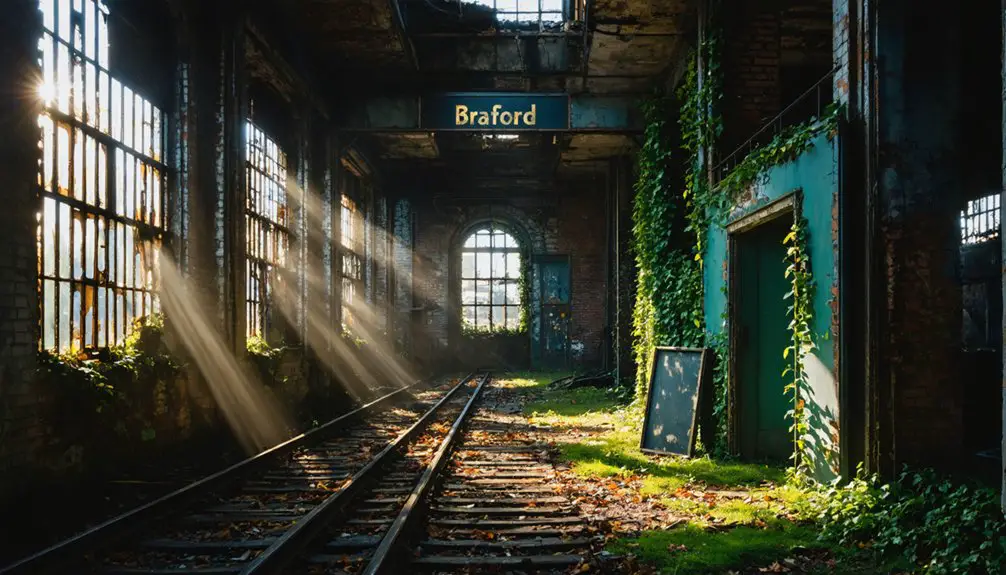You’ll find Smith’s Castle in Rhode Island’s Narragansett Country, where it began as a fortified trading post in 1637 before evolving into America’s oldest surviving plantation house. While it’s not technically a ghost town, the historic site carries echoes of its dramatic past – from King Philip’s War to Elizabeth Singleton’s famous ghost. Today, you can tour the restored castle, where archaeological discoveries and untold stories of colonial life, military conflicts, and enslaved peoples await your exploration.
Key Takeaways
- Smith’s Castle is not a ghost town but a historic plantation house in North Kingstown, Rhode Island, designated as a National Historic Landmark.
- The site features reported paranormal activity including Elizabeth Singleton’s ghost, an aggressive colonial soldier spirit, and Phoebe Condon’s apparition.
- Disembodied voices and footsteps are frequently reported throughout the castle, particularly near escape tunnels used by enslaved individuals.
- A mass grave containing forty colonial soldiers from the Great Swamp Fight of 1675 is located on the property.
- The grounds include approximately 200 unmarked graves of enslaved people, contributing to the site’s haunted reputation.
The Birth of a Colonial Trading Post
Two pivotal trading posts established at Cocumscussoc in 1637 marked the beginning of colonial commerce in Rhode Island.
You’ll find the trading post origins trace back to Roger Williams, who received the land as a gift from the Narragansett Tribe to foster trade between cultures. As founder of Rhode Island and a Baptist theologian, Williams built the first post, but Richard Smith Sr. soon followed with his own nearby establishment.
Smith’s structure was particularly significant – it’s recognized as the first English house in Nahigonsik country, built as a fortified trading center and residence. The original structure unfortunately met its fate when it was burned in 1676 during a regional conflict. Today, the site is recognized as a National Historic Landmark for its cultural significance.
Richard Smith’s fortified trading post marked a milestone as the first English house established in Narragansett territory.
These posts became essential hubs for early commerce, where you’d find European settlers and Narragansett people exchanging goods freely. Their strategic location next to Native American burial grounds and settlements created a unique intersection of colonial and indigenous life.
Legacy of Richard Smith’s Vision
Although Richard Smith Sr. began as a trader at Cocumscussoc, his vision transformed the site into one of colonial America’s most significant social and economic hubs.
You’ll find his economic model was brilliantly calculated – he expanded from trading to agriculture while relying on enslaved labor to build a lasting colonial enterprise.
His transition from beaver pelts to livestock and cheese production demonstrated his ability to adapt and capitalize on changing market demands.
Today, you can still witness Smith’s legacy through the preservation efforts of the Cocumscussoc Association. Since 1948, they’ve maintained the site’s significance as America’s oldest surviving plantation house.
You’ll discover how Smith’s strategic location choice and continuous land acquisition created a stronghold that dominated regional politics and trade.
The castle’s sturdy construction and expansive grounds stand as a symbol of his enduring vision, now serving as an educational resource that chronicles the complex intersection of colonial, Native American, and African American histories.
When Smith built the first English house in Nahigonsick Countrey, he established a permanent foothold for colonial expansion in the region.
Military Fortress During King Philip’s War
You’ll find Smith’s Castle’s most prominent role emerged during King Philip’s War in 1675, when it served as the primary fortification and staging ground for colonial militia forces from Massachusetts, Connecticut, and Plymouth.
Under Governor Josiah Winslow’s command, the colonial army included over 1,000 militiamen from the three colonies.
Richard Smith Jr. rebuilt the structure after the devastating war ended, restoring it to prominence.
From this strategic location, colonial troops launched the brutal Great Swamp Fight against the Narragansett stronghold, resulting in heavy casualties with roughly 70 colonists killed, 150 wounded, and 40 soldiers buried in a mass grave on the castle grounds.
The Narragansett people later retaliated by burning Smith’s Castle to the ground in 1676, marking a pivotal moment that intensified hostilities and brought the Narragansett fully into the war.
Strategic Military Location
During King Philip’s War in 1675-76, Smith’s Castle emerged as an indispensable military stronghold in colonial New England, serving as both a fortified trading post and primary supply base for colonial forces.
You’ll find the site’s military logistics were critical, positioned deep within Narragansett territory, where it provided a significant foothold for colonial operations.
The castle’s tactical advantages made it an ideal rallying point for militia preparing to attack Narragansett lands. It’s where Governor Josiah Winslow coordinated joint colonial forces and allied with Mohegan and Pequot warriors. The combined force included 150 to 200 allies from these indigenous tribes who were traditional enemies of the Narragansetts.
Originally built by Richard Smith, the garrison house served as a crucial defensive structure until its destruction during the war.
The site’s proximity to the Great Swamp allowed for rapid deployment during raids and battles. A timely supply ship even prevented troop starvation during the campaign, though the position’s exposure led to heavy casualties and the castle’s eventual burning in 1676.
Colonial Troop Base Operations
The colonial fortress at Smith’s Castle transformed into a bustling military command center in 1675, coordinating troops and supplies for the devastating campaign against the Narragansett tribe.
You’ll find this strategic base was essential for troop logistics, serving as both a supply depot and staging ground where Massachusetts, Connecticut, and Plymouth forces gathered alongside Mohegan and Pequot allies. The United Colonies alliance had formed decades earlier in 1643 to strengthen mutual security against potential uprisings.
The early European contact with native peoples in the region dated back centuries before this conflict, impacting tribal relations and territories.
As you explore the castle’s military history, you’ll discover how it functioned as a forward operating base where colonial commanders planned their strategies.
Supply ships docked nearby to prevent troop starvation during harsh winter campaigns.
The fortress served multiple roles: launching point for expeditions, safe haven for wounded soldiers, prisoner detention facility, and coordination hub for both diplomatic efforts and military intelligence gathering through captured indigenous informants.
Great Swamp Fight Impact
After securing their position at Smith’s Castle, colonial forces launched a devastating assault on the nearby Narragansett stronghold in what became known as the Great Swamp Fight of December 19, 1675.
You’ll find this turning point in Colonial Relations marked by the betrayal of a Narragansett guide who led approximately 1,150 troops to breach the tribe’s fortified winter quarters.
The battle proved catastrophic for the Narragansett people – nearly 400 innocent civilians perished alongside their warriors.
After the bloodshed, surviving colonial forces retreated to Smith’s Castle to regroup.
The massacre effectively crippled Narragansett resistance by destroying their food supplies and shelter just as winter set in.
This brutal victory shifted the war’s momentum decisively in the colonists’ favor, forever changing the power dynamics in colonial New England.
From Ashes: The Castle’s Rebirth

Rising from the ashes of King Philip’s War in 1675, Smith’s Castle underwent a remarkable transformation that would span centuries.
Richard Smith Jr. rebuilt the structure around 1678, cleverly reusing salvaged timbers from the original trading post.
You’ll find layers of architectural preservation throughout the building, from colonial elements to Victorian additions.
Life on a Colonial Plantation
During colonial times, Smith’s Castle transformed from a humble trading post into one of Narragansett Country’s most significant plantations, where complex social dynamics played out between the Smith-Updike families, enslaved African Americans, and neighboring Indigenous peoples.
You’ll discover how the plantation economy thrived through generations of forced labor, with Daniel Updike’s 1757 will listing nineteen enslaved people – the largest documented slaveholding in the region.
While the cultural narratives of these individuals remain largely untold, their contributions shaped every aspect of life at Smith’s Castle.
- The Updike family actively financed slave trade voyages to Africa and West Indies.
- Enslaved workers maintained both household and agricultural operations.
- The property served as a hub for social, political, and religious activities.
- Multiple generations of enslaved families sustained the plantation’s prosperity.
Tales of Haunted Hallways
You’ll encounter various spirits within Smith’s Castle’s haunted halls, from Elizabeth Singleton’s recurring screams near the staircase where she met her death to the phantoms of colonial soldiers who rest in the nearby mass grave.
The castle’s dark history comes alive through reports of Indigenous spirits who suffered brutal fates and the echoing cries of former slaves, their presence felt in sudden cold spots and unexplained footsteps.
When you walk through these historic corridors, you’ll witness the layers of tragedy etched into the very foundations, from the violent events of King Philip’s War to Mr. Jackson’s lingering presence from his 1741 murder.
Vengeful Spirits Roam Free
When you enter Smith’s Castle today, you’ll find yourself walking the same haunted hallways where multiple spirits are said to still roam freely.
The vengeful spirits here range from tragic socialites to colonial soldiers, each with their own haunting tale to tell.
- Elizabeth Singleton’s ghost replays her fatal tumble down the stairs, accompanied by screams and breaking sounds.
- An aggressive colonial soldier appears with his musket, known to fire at unsuspecting visitors.
- Phoebe Condon watches intently from upstairs windows, her ghostly figure visible in certain light.
- Underground, the tormented spirits of slaves who perished in escape tunnels cry out in anguish.
Your ghostly encounters might include footsteps echoing through empty corridors, disembodied voices, or even face-to-face meetings with these restless souls who refuse to leave their former home.
Colonial Soldiers’ Final Rest
Beyond the castle’s eerie halls lies an even more chilling reminder of its violent past – a mass grave containing the remains of forty colonial soldiers who fell during the Great Swamp Fight of 1675.
As you walk these historic grounds in North Kingstown, you’ll find this solemn burial site where militia members were hastily interred following the brutal battle with Narragansett forces.
Unlike the marked family plots and slave burial grounds nearby, these fallen soldiers share an unmarked grave, their individual identities lost to time.
Local lore suggests their soldier spirits still linger, particularly near the spot where Joshua Tefft, a militia man turned traitor, met his grim execution.
The property’s violent history of warfare, betrayal, and death has forever marked this land as a place where past and present collide.
Slave Past Lives On
While colonial soldiers rest in their unmarked grave, another powerful presence haunts Smith’s Castle’s ancient hallways – the spirits of over 200 enslaved individuals who lived, worked, and died on these grounds.
You’ll feel their historical memory lingering in every corner of this former plantation, where enslaved lives built and maintained the property for over 150 years.
- The burial ground holds about 200 graves of enslaved people, marking their final resting place
- Richard Smith Jr. owned eight enslaved individuals as early as 1692
- The Updike family later freed their slaves in the 1770s-1780s
- Today, a Rhode Island Slave History Medallion honors their legacy
Their stories echo through time, preserved in archaeological findings, oral histories, and the very walls of Smith’s Castle, demanding recognition and remembrance.
Archaeological Discoveries and Mysteries
Through three major archaeological projects led by the University of Rhode Island’s John Senulis, Smith’s Castle has disclosed a treasure trove of colonial artifacts and architectural evidence dating to the 17th and early 18th centuries.
You’ll find archaeological techniques disclosed deep pockets of brown loam and shell-tempered mortar layers, marking distinct periods of construction and destruction.
Artifact interpretation shows fascinating details of colonial life through Delftware, lead-glazed slipware, and pipe stems with varying bore sizes.
The most compelling discoveries include window cames and pane glass fragments buried beneath mortar deposits, likely from when the original trading post burned in 1675.
These ruins tell a story of resilience – as settlers salvaged materials to rebuild in 1678, leaving behind physical evidence that matches historical accounts of this fortified colonial outpost.
Modern-Day Heritage Site
Since its designation as a National Historic Landmark in 1993, Smith’s Castle has emerged as Rhode Island’s premier colonial heritage site at 55 Richard Smith Drive near Wickford.
You’ll discover America’s oldest surviving plantation house, meticulously restored in the 1950s to preserve its historic integrity while enhancing the visitor experience.
- Experience living history through guided tours of the 17th-century block house
- Explore colonial-inspired gardens featuring period-accurate dye plants and herbs
- Attend the annual Strawberry Festival and special events that bring history alive
- Learn about Native American relations, colonial trade, and the impact of slavery
The site’s heritage tourism draws visitors year-round, while community engagement programs continue to strengthen local connections through educational outreach and cultural preservation efforts.
Frequently Asked Questions
What Is the Best Season to Visit Smith’s Castle?
You’ll find summer’s your best bet for visiting, with peak weather conditions and maximum tour availability. Plus, you’ll enjoy special seasonal events like historic reenactments, talks, teas, and tastings June through August.
How Much of the Original 1637 Trading Post Structure Remains Today?
You won’t find any of the original structure standing today – it was completely destroyed in 1676. All that’s left are archaeological remains beneath the ground and historical renovations from 1678 onward.
Are There Guided Tours Available for School Groups and Organizations?
Like stepping back in time, you can book guided educational experiences for your group of 10 or more. Group reservation options include tours Friday through Sunday, May to mid-October, with special accommodations through November.
What Native American Artifacts Have Been Found on the Property?
You’ll find significant Native artifacts including pottery shards, stone tools, projectile points, shell ornaments, and beads. Fire-cracked rocks and bone fragments indicate ancient hearth sites and daily activities.
Can Visitors Access the Historic Rabbit Island Portion of the Grounds?
You’ll find limited information about Rabbit Island access, though you can explore the main grounds freely. Despite its historic significance, specific visitor permissions for the island aren’t clearly documented.
References
- https://www.youtube.com/watch?v=ECp3vqQQB88
- https://ournewenglandlegends.com/podcast-123-whos-haunting-smiths-castle/
- https://preservation.ri.gov/sites/g/files/xkgbur406/files/pdfs_zips_downloads/national_pdfs/north_kingstown/noki_post-road_smiths-castle-amendment.pdf
- https://www.smithscastle.org/our-history
- https://www.smithscastle.org
- https://rishm.org/washington-county/north-kingstown/smiths-castle-wickford/
- https://sites.google.com/rockyhill.org/atsmithscastle/home
- https://theclio.com/entry/94609
- https://www.americanheritage.com/content/smiths-castle
- https://www.smithscastle.org/the-cocumscussoc-review/2023/2/6/the-servants-of-richard-smith-the-elder



